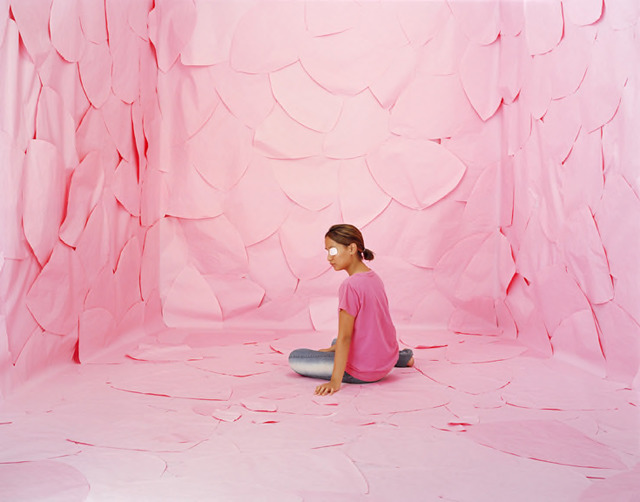Why Asian Photography?
Skip other details (including permanent urls, DOI, citation information): This work is licensed under a Creative Commons Attribution-NonCommercial-NoDerivatives 3.0 License. Please contact [email protected] to use this work in a way not covered by the license.
For more information, read Michigan Publishing's access and usage policy.
Patrick FLORES
 Untitled (Turquoise Room #4). 48’’ x 60’’ Lightjet Photograph. 2007. Edition of 3 + 2AP. © Gina Osterloh. Courtesy of the Artist, Silverlens Gallery(Manila) and Francois Ghebaly gallery (Los Angeles)
Untitled (Turquoise Room #4). 48’’ x 60’’ Lightjet Photograph. 2007. Edition of 3 + 2AP. © Gina Osterloh. Courtesy of the Artist, Silverlens Gallery(Manila) and Francois Ghebaly gallery (Los Angeles)
 Blind Rash (Shooting Blanks). 30’’ x 38’’. Lightjet Photograph. 2008. Edition of 4 + 2AP. © Gina Osterloh. Courtesy of the Artist, Silverlens Gallery(Manila) and Francois Ghebaly gallery (Los Angeles)
Blind Rash (Shooting Blanks). 30’’ x 38’’. Lightjet Photograph. 2008. Edition of 4 + 2AP. © Gina Osterloh. Courtesy of the Artist, Silverlens Gallery(Manila) and Francois Ghebaly gallery (Los Angeles)
Alighting
How do we resist photography in a time immersed in image? With much difficulty certainly, because of its sheer immediacy and compelling wonder, capturing an authentic, everyday anecdote or an alluring, otherwordly effect.
And so, how do we go against its grain? To permeate the picture with context, so that photography could not exist without that which is against, besides, and beyond it? Or might it be productive to let the experience of photography provisionally prosper in a personal sphere, away from the simulations of a highly mediatized world, within a zone of contact like a museum, an institution that evokes history in the present and through a subject that sees through?
These are questions that I pondered as I organized a photography exhibition in Manila in 2008, a tangent to the Japanese counterpart titled Counter- Photography. If the latter is interested in probing the medium’s tendency to document, the Philippine exhibition is keen on the politics of this tendency in the context of contemporary photography in the country and to some extent in Southeast Asia. In Thailand, for instance, the King in the nineteenth century decided to breach taboo and let his image be reproduced in photography, which was like stealing the spirit. In Indonesia, a photographer named Cephas worked for the Sultan of Yogyakarta and took images of custom and place, from the wayang performances to the magnificent Borobodur.
The archival tableau of an imposing Dean C. Worcester standing next to a seemingly importuned Philippine native is emblematic of this predicament: a census taker, culture translator, and museum maker had required the photograph to record the ethnic woman, measure her in light of his stature, regard her as a type, and infer character from the pose.
The history of photography in the Philippines is marked by this form of revelation: making something known, staging the apparent so that consciousness could be heightened, conquering the fear of invisibility. Undoubtedly, such scrutiny can either ravage the subject, reducing her to a thing of tradition, or entitle her presence as she transfigures into what the National Hero Jose Rizal would call a double vision, an enchantment of affinities, in his uncanny Spanish: “el demonio de las comparaciones.” Comparisons, indeed, bedevil, bewitch.
Photography, therefore, in a post-colonial situation questions the condition through which it has gained recognition as a medium: how its capacity to reveal is at once the technique to conceal and how its attempt to give a truthful depiction of everyday life is in the same vein a desire to play out a fantasy of the self and the other, the photographer and the photographed. It is, therefore, at once radically empirical and irreducibly allegorical: so present, so foretelling.
Here, the duality between appearance and absence does not hold; it gives way to a kind of disclosure, an inclination outward, a history of image and photography that is an opening. The exhibition “Swarm in the Aperture”: Recent Photography in the Philippines discerns the depth of this crevice, this slit in time that light apprehends. The title is taken from Eric Baus’s poem “She Said I Was Tired of Living Like a Sieve in a House Between Atmospheres” that enigmatically speaks of a quotidian sublime. It ends with the line: “What I'm asking for is a fish border, a fence equal to her scattered breath.” The multitude at the fringes of the frame finally hovers.
Gathered in this modest project are eleven photographers who have in various ways invested talent and temperament in the discipline, whose practice is distinct from contemporary installations that appropriate photography, or photo media, and from exclusively commercial pursuits that mistake the picturesque for the beautiful. Exhibitions of photography in the Philippines come few and far between, and there seems to be little room in the art world for artists to explore the range of this form with both rigor and whimsy. It is tempting to confine the tendencies in these expressions within such convenient categories as conceptual or photojournalistic, experimental or social realist, ethnographic or formalist. But we would rather offer a wide latitude and prompt everyone to engage the photographs with intimacy, and take away from this process of creative cherishing nothing less than a critical memory of “image” as a postcolonial condition: coveted as appearance, obscured as truth, disclosed as reality, document of dignity, evidence of inequity.
Patrick Flores is Curator of the Vargas Museum, Adjunct Curator of the National Art Gallery, Singapore,and Professor of Art History, University of the Philippines. He is the author of Painting History: Revisions in Philippine Colonial Art(1998).




